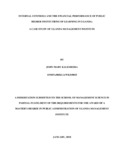| dc.description.abstract | Following an external Audit by the Auditor General (FY 2015/16), in the management letter, key
issues were raised to the management of UMI relating to suspected payroll fraud, diversion of
funds, regular disappearance of payment documents for associate consultants, inadequate
staffing, overwhelmingly increasing Accounts Receivables and Accounts Payables that evidence
insufficient internal controls which may affect the enhancement of the Institute’s
competitiveness and financial sustainability as part of her strategic objectives, thus motive for the
study. The purpose of the study was to find out the relationship between internal controls and the
financial performance of UMI. Specifically the study sought to establish the relationship between
internal controls (control environment, monitoring and control activities) on the financial
performance (Accounts Receivables and Accounts Payables) of UMI. The objectives of this
study were to examine the relationship between control environment and financial performance
in UMI; to examine the relationship between monitoring and financial performance in UMI; to
investigate the relationship between control activities and financial performance in UMI. A
correlation research design was adopted and both qualitative and quantitative approaches were
used. UMI Directors and Deans, internal audit team, finance and accounts, planning, monitoring
and evaluation, quality assurance, human resource, procurement and ICT departmental staff
participated in the study, out of 40 respondents, 37 participated in the study giving a response
rate of (92.5%), data analysis was performed using inferential and descriptive statistics that
included mean and standard deviations, The data was collected using self-administered
questionnaires and an interview guide and analyzed using SPSS (descriptive statistics, Pearson
correlation coefficients as well as regression analysis). The conclusions of the study were that
there was a very significant positive relationship between internal control environment and the
financial performance (72.4%), a very strong positive significant relationship between internal
control monitoring and financial performance (84.7%), and a moderate significant positive
relationship between internal control activities and financial performance (48.5%). The lessons
learnt were that even though policies are in place and not known by all staff, their
implementation may be stagnated, also without a strong participatory management, the tone of
the entire control environment is degraded, however, without proper segregation of tasks all
through the control sphere, the control activities are doomed to fail and thus poor financial
performance. Consequently the recommendations were that UMI should constantly review her
policies, UMI should embrace the modern ICT controls to guide in monitoring of accounts
receivables and accounts payables, UMI should optimally utilize her resource envelop by
sticking to budgets and also decentralizing the services of the quality assurance and the planning,
monitoring and evaluation departments to school level, enhancing continued training of the
finance and accounts personnel in order to devise means of managing accounts receivables and
accounts payables. In the long run management should ensure constant feedback and two way
communications in cases of management letter and on other periodic reports produced by heads
of departments and the internal and external audit team to sustain organizational learning. | en_US |

